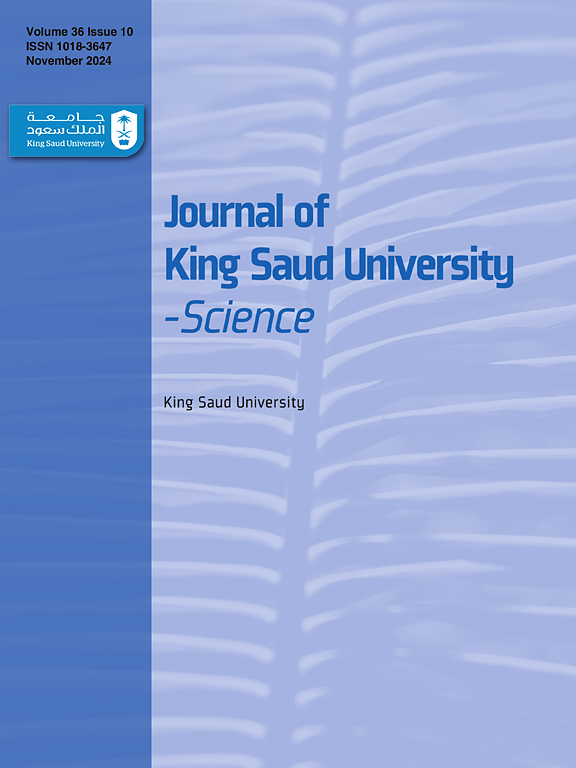Nickel toxicology testing in alternative specimen from farm ruminants in a urban polluted environment
IF 3.7
3区 综合性期刊
Q1 MULTIDISCIPLINARY SCIENCES
引用次数: 0
Abstract
The impact of nickel (Ni) metal toxicity, on public health was assessed analyzing forage samples (Acacia nilotica, Zea mays, Pennisetum glaucum, Capparis decidua and Medicago sativa), soils and blood samples of cow, buffalo and sheep (blood plasma, fecal, and hair) collected from three different agro-ecological zones and analyzed through atomic absorption spectrophotometer. Results showed that nickel values differed in soil samples ranging from 4.49 to 9 to 25 mg/kg, in forages from 3.78 to 9.53 mg/kg and in animal samples from 0.65 to 2.42 mg/kg. Nickel concentration, in soil and forage samples, was below the permitted limits. Soil with the minimum nickel level was found under C. decidua while the maximum concentration was reached under the A. nilotica. Among the animals, nickel was maximum in buffaloes that grazed on the Z. mays fodder. Ni was more accumulated in feces than other body tissues. The sheep and buffaloes showed high vulnerability to Ni pollution due to the highest contamination levels at site II and III. Bioconcentration factor, pollution load index and enrichment factor were found to be higher in buffaloes than cows, respectively. The daily intake and health risk index ranged from 0.0056 to 0.0184 mg/kg/day and 0.186–0.614 mg/kg/day respectively. In short, the results of this study evidenced that Nickel-containing fertilizers should never not be used to grow forage species. Government should to lessen the toxic metal accessibility to animals. Although general values were lower than the admitted limit, nickel can be accumulated and the consume of food containing nickel can increase health risks. General monitoring of soil and vegetation pollution load, as well as the use of other non-conventional water like canal water for forage irrigation could be a sustainable solution to decrease the access of nickel in the food chain.
城市污染环境中农场反刍动物替代标本中的镍毒理学测试
通过原子吸收分光光度计分析从三个不同农业生态区采集的饲草样本(金合欢、玉米、Pennisetum glaucum、Capparis decidua和Medicago sativa)、土壤以及奶牛、水牛和绵羊的血液样本(血浆、粪便和毛发),评估了镍(Ni)金属毒性对公众健康的影响。结果显示,土壤样本中的镍值从 4.49 至 9 至 25 毫克/千克不等,牧草样本中的镍值从 3.78 至 9.53 毫克/千克不等,动物样本中的镍值从 0.65 至 2.42 毫克/千克不等。土壤和饲草样本中的镍浓度均低于允许限值。C. decidua 的土壤中镍含量最低,而 A. nilotica 的土壤中镍含量最高。在动物中,吃玉米饲料的水牛体内的镍含量最高。镍在粪便中的累积量高于其他身体组织。绵羊和水牛对镍污染的易感性很高,因为二号和三号地点的污染水平最高。水牛的生物富集因子、污染负荷指数和富集因子分别高于奶牛。水牛的日摄入量和健康风险指数分别为 0.0056 至 0.0184 毫克/千克/天和 0.186 至 0.614 毫克/千克/天。总之,这项研究结果表明,含镍肥料绝不能用于种植牧草。政府应减少动物接触有毒金属的机会。虽然一般数值低于允许限值,但镍会累积,食用含镍食物会增加健康风险。对土壤和植被的污染负荷进行全面监测,以及使用其他非常规水(如用于牧草灌溉的运河水),可能是减少食物链中镍含量的可持续解决方案。
本文章由计算机程序翻译,如有差异,请以英文原文为准。
求助全文
约1分钟内获得全文
求助全文
来源期刊

Journal of King Saud University - Science
Multidisciplinary-Multidisciplinary
CiteScore
7.20
自引率
2.60%
发文量
642
审稿时长
49 days
期刊介绍:
Journal of King Saud University – Science is an official refereed publication of King Saud University and the publishing services is provided by Elsevier. It publishes peer-reviewed research articles in the fields of physics, astronomy, mathematics, statistics, chemistry, biochemistry, earth sciences, life and environmental sciences on the basis of scientific originality and interdisciplinary interest. It is devoted primarily to research papers but short communications, reviews and book reviews are also included. The editorial board and associated editors, composed of prominent scientists from around the world, are representative of the disciplines covered by the journal.
 求助内容:
求助内容: 应助结果提醒方式:
应助结果提醒方式:


